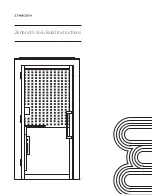
Triggering on Signals
3–160
TLS 216 User Manual
threshold level to trigger on a waveform edge. As previously stated, these two
controls also work with pulse triggering.
To force the logic scope to immediately start acquiring a waveform, even without
a trigger event occurring, press the FORCE TRIG front-panel button. (See
Figure 3-72.) Use FORCE TRIG with any of the five trigger types.
When in Normal trigger mode, use FORCE TRIG to quickly determine if there
is a signal present for the logic scope to acquire. Once signal presence is
established, you can determine how to trigger on it (press SET LEVEL TO 50%,
check trigger source setting, and so on).
The logic scope forces acquisition even when you press FORCE TRIG before the
end of pretrigger holdoff. However, pressing FORCE TRIG does not restart the
acquisition system when stopped (for instance, by pressing the RUN/STOP
button).
To trigger on the next valid trigger event and then stop, press SHIFT
➞
SINGLE TRIG. Now press the RUN/STOP button each time you want to
initiate a single sequence of acquisitions. Use SINGLE TRIG with any of the
five trigger types.
To leave Single Trig mode, press SHIFT
➞
ACQUIRE MENU
➞
Stop After
(main)
➞
RUN/STOP Button Only (side).
Read the description under Set Stop After Mode on page 3–20 for further
information on single sequence acquisitions.
To Determine Trigger Status
To quickly determine partial trigger status (for instance, if the logic scope is
triggered, its trigger type, and the type of trigger selected), use the trigger status
lights and the trigger readout.
To determine the state of the trigger circuitry, watch the three status lights in the
Trigger control area. (See Figure 3-72.) The lights are labeled TRIG’D, READY,
and ARM. Use the trigger status lights with any of the five trigger types.
When TRIG’D lights, it means the logic scope has recognized a valid trigger and
is filling the posttrigger portion of the waveform.
When READY lights, it means the logic scope can accept a valid trigger event
and it is waiting for that event to occur.
When ARM lights, it means the trigger circuitry is filling the pretrigger portion
of the waveform record.
Force a Trigger
Trigger a Single Sequence
Monitor the Trigger
Status Lights
Summary of Contents for P6240
Page 5: ......
Page 7: ......
Page 15: ...Table of Contents viii TLS 216 User Manual...
Page 20: ...Getting Started...
Page 26: ...Start Up 1 6 TLS 216 User Manual...
Page 51: ...Operating Basics...
Page 53: ...Overview 2 2 TLS 216 User Manual...
Page 73: ...Acquisition 2 22 TLS 216 User Manual...
Page 82: ...Reference...
Page 94: ...Adjusting the Vertical Setup 3 12 TLS 216 User Manual...
Page 104: ...Choosing an Acquisition Mode 3 22 TLS 216 User Manual...
Page 112: ...Choosing a Group Display Mode 3 30 TLS 216 User Manual...
Page 122: ...Customizing the Display 3 40 TLS 216 User Manual...
Page 130: ...Customizing the Display Colors 3 48 TLS 216 User Manual...
Page 162: ...Measuring Waveforms Automatically 3 80 TLS 216 User Manual...
Page 168: ...Measuring Waveforms with Cursors 3 86 TLS 216 User Manual...
Page 178: ...Printing a Hardcopy 3 96 TLS 216 User Manual...
Page 186: ...Probing of Circuits 3 104 TLS 216 User Manual...
Page 198: ...Saving and Recalling Waveforms 3 116 TLS 216 User Manual...
Page 222: ...Triggering on Patterns 3 140 TLS 216 User Manual...
Page 252: ...Triggering on States 3 170 TLS 216 User Manual...
Page 256: ...Viewing Status 3 174 TLS 216 User Manual...
Page 261: ...Appendices...
Page 283: ...Appendix B Algorithms B 18 TLS 216 User Manual...
Page 285: ...Appendix C Packaging for Shipment C 2 TLS 216 User Manual...
Page 290: ...Glossary...
Page 302: ...Glossary Glossary 12 TLS 216 User Manual...
Page 303: ...Index...
Page 319: ...Index Index 16 TLS 216 User Manual...
Page 320: ......
Page 321: ......
















































